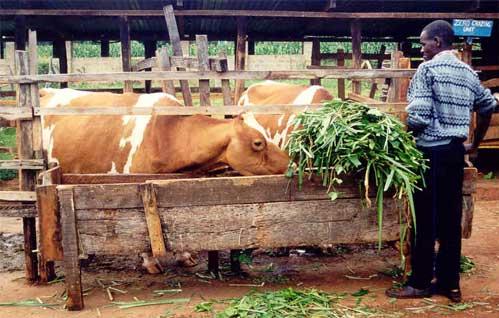Harvesting
The first cutting is expected 3 – 4 months after planting (when at one meter high).
At first harvesting it is recommended that the cutting be done at a height of 5 cm from the soil/ground. This is to allow for more growth of new shoots.
Cutting intervals usually depend on rainfall availability and the level of management.
Successive harvests should be done when the crop is 1.5 meters.
Napier should be cut 5 cm from the ground.
Expected yield is 20,000 to 40,000 kg of fresh Napier per acre. Note the yield depends of the level of management.
Utilization
Napier grass is fed under the cut and curry system.
Freshly cut Napier grass is left to wilt for a period of 12 hours under shade before chopping is done.
Chop the material into pieces about 5 cm long to avoid wastage.
Requirements for a dairy cow of average live weight of 400 kg should be given about 60 kgs of fresh chopped Napier grass per day.
Conservation & Storage
Conserve the surplus whenever there is more Napier grass at the right stage of harvesting.
The ideal method of conservation is by silage making.
It can also be left as standing hay.
Methods of silage making
- Trench silo
- Pit silo
- Above ground – Tower
- Tube silo
The commonly used methods by most small scale dairy farmers are the trench and tube silo
Tube Silo
- Make silage using giant (1 m wide) polythene or tubes.
- Heavier polythene is desirable since it can be re-used many times though expensive.
- Requirements per day for a 400 kg cow is 45 kg.
Requirements
- 1 gunny bag full of Napier grass is chopped to length of about 2.5 cm using a chaff cutter or panga.
- A watering can
- 1 kg of molasses
- 3 kg of water measured in the same way bas molasses
- A shovel
- A giant polythene bag or tube tied with sisal twine at one end.
Procedure
- Mix 1 kg of molasses with 3 kg of water in a watering can.
- Spread out the chopped Napier on a polyyhene sheet and sprinkle with the molasses water mixture. Mix the Napier with the molasses –water well.
- Put the mixed material in the giant polythene bag.
- Compress the material being careful not to break the polythene bag.
- Tie the top of the bag with sisal twine.
- The silage is ready for use after 3 weeks.
Trench Silo
- Excavate a trench (Dimensions 3 m by 5.3 m by 1 m for the deep side; enough to accommodate 8 tons of silage).

- Consumption per cow per day is 45 kgs per day. Therefore 8 tons of ensiled material can feed a 400 kg cow for 170 days.
- Lay the polythene materials on the side of the trench
- Cut the fodder material into pieces of 2.5 – 5 cm length.
- Empty twenty two gunny bags of chopped material into the silo and spread evenly.
- Mix half to three quarters jerrican of molasses with two to three jerricans of water and evenly sprinkle on the chopped material in the silo.
- After sprinkling compact adequately with a drum filled with water.
- Continue the process until the pit is full and doom shaped.
- Cover the chopped material with a polythene sheet then cover with soil of at least 1 feet (30 cm) thickness to further compress the material.

